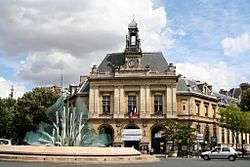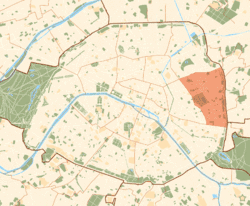20th arrondissement of Paris
| 20th arrondissement of Paris XXe arrondissement | |
|---|---|
| French municipal arrondissement | |
 City hall | |
 Paris and its closest suburbs | |
| Country | France |
| Region | Île-de-France |
| Department | Paris |
| Commune | Paris |
| Government | |
| • Mayor | Frédérique Calandra |
| Area | |
| • Total | 5.98 km2 (2.31 sq mi) |
| Population (8 March 1999 census)[p] | |
| • Total | 182,952 |
| • Estimate (2005) | 191,800 |
| • Density | 31,000/km2 (79,000/sq mi) |
| ^[p] Population sans doubles comptes: single count of residents of multiple communes (e.g. students and military personnel). | |
 20 arrondissements of Paris | |||||||||||||||||||||||||||||||||||||
|---|---|---|---|---|---|---|---|---|---|---|---|---|---|---|---|---|---|---|---|---|---|---|---|---|---|---|---|---|---|---|---|---|---|---|---|---|---|
| |||||||||||||||||||||||||||||||||||||
The 20th (or XXe or vingtième) arrondissement of Paris is the last of the consecutively numbered arrondissements of that French capital city. Also known as Ménilmontant, it is located on the right bank of the River Seine and contains the city's cosmopolitan districts Ménilmontant and Belleville.
The 20th arrondissement is also internationally known for the Père Lachaise Cemetery where one can find the tombs of many famous artists.
Geography
The land area of this arrondissement is 5.984 km2 (2.31 sq. miles, or 1,479 acres).
Demographics
The population of Paris's 20th arrondissement peaked in 1936, when it had 208,115 inhabitants. Today it remains very dense in population and business activity with 182,952 inhabitants and 54,786 jobs as of the last census, in 1999.
Historical population
| Year (of French censuses) |
Population | Density (inh. per km2) |
|---|---|---|
| 1872 | 92,772 | 15,503 |
| 1936 (peak of population) | 208,115 | 34,779 |
| 1954 | 200,208 | 33,457 |
| 1962 | 199,310 | 33,307 |
| 1968 | 188,921 | 31,571 |
| 1975 | 175,795 | 29,378 |
| 1982 | 171,971 | 28,738 |
| 1990 | 184,478 | 30,829 |
| 1999 | 182,952 | 30,574 |
| 2009 | 197,067 | 32,954 |
Immigration
| |||||||||||||||||||
Cityscape
Places of interest
- Parc de Belleville
- Père Lachaise Cemetery
Containing the tombs of many famous artists: composers (such as Frédéric Chopin and Gioacchino Rossini), writers (including Oscar Wilde, Honoré de Balzac, and Marcel Proust), painters (Camille Pissarro, Jacques-Louis David, Eugène Delacroix, and others), musicians (Jim Morrison of The Doors and Edith Piaf among others), and the playwright Molière.
Important districts
- District of Belleville
- District of Ménilmontant
Government and infrastructure
The Directorate-General for External Security (DGSE) has its head office in the arrondissement.[1]
Media
The humour publication Charlie Hebdo has its head office in the arrondissement.[2]
Education
Senior high schools include:
- Lycée Hélène Boucher
- Lycée Maurice-Ravel
- Lycée Charles-de-Gaulle
- Lycée Beth Yacov
- Lycée Heikhal Menahem Sinaï
Other institutions:
- École Vitruve
References
- ↑ "Direction générale de la sécurité extérieure (DGSE)". Service-public.fr (French government). Retrieved on 31 January 2014. "141, boulevard Mortier 75020 Paris"
- ↑ "Contact Archived 2012-09-18 at the Wayback Machine.." Charlie Hebdo. Retrieved on 21 September 2012. "Charlie Hebdo 26, rue Serpollet 75020 PARIS"
External links

- Joining the Locals In Paris’s East – slideshow by The New York Times
| Wikimedia Commons has media related to Paris 20e arrondissement. |
Coordinates: 48°51′54.22″N 2°23′56.58″E / 48.8650611°N 2.3990500°E